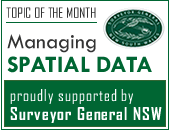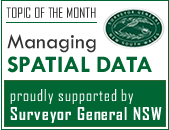Managing Spatial Data
editor | July 31, 2009

Surveyor General NSW is the proud sponsor of
August 2009’s Topic of the Month: Managing Spatial Data.
 To the uninitiated, it can sound complicated and technical, but spatial data is part of everyday life.
To the uninitiated, it can sound complicated and technical, but spatial data is part of everyday life.When we think “spatial data”, global positioning system (GPS) technology springs to mind; but it isn’t just about specialist applications. Mobile phones, eTags, credit card statements, Facebook profiles and the humble postcode all contain important personal spatial information.
Spatial data has lots of practical applications:
- Orientation – Where am I?
- Navigation – How do I get there?
- Location – Where are things in relation to one another?
- Identification – What is this?
- Event check – What happens here?
Since Open Forum’s last featured forum on Spatial Data in July 2008, spatial has been making the headlines.
Google’s bushfire map mashup and the Victorian Country Fire Service’s RSS feed during the February 2009 Victorian bushfires are great examples of open spatial information in action. Community members also set up Twitter feeds to help fire affected residents stay up to date.
How much public information governments can and should make available for such mashups is a topic of hot debate. Currently one of the key areas of interest for the Federal Government 2.0 Taskforce is to examine the possibilities of making government data more open, and this presents a number of interesting questions about how individuals as well as organisations from the public and private sectors manage spatial data.
There are some particularly exciting possibilities for the application of advanced spatial data across many policy areas; particularly in health, education, emergency services, and climate change. However, to maximise the benefit to the community; effective standards and regulation concerning the way we manage spatial information must be enforced.
 Please share your views on this issue by completing our short survey "What does Spatial Information mean to you?"
Please share your views on this issue by completing our short survey "What does Spatial Information mean to you?"And join in on this forum. Follow the links below to read the related blogs and articles. We have invited some leading spatial data experts to contribute. You can log in and post your questions and comments in response. Or, if you have any general thoughts, just post them on the noticeboard below.
If you would like to contribute you own blog, of 350-600 words, please contact srose@openforum.com.au. If you are new to blogging, check out our Top 10 Blogging Tips.
Email story tip-offs and contributor suggestions to srose@openforum.com.au
__________________________________________
RELATED CONTENT:
- OPEN FORUM SURVEY: What does Spatial Information mean to you?
- Location Based Services of the Future – by Warwick Watkins
- Privacy and Location Based Information – by Warwick Watkins
- Political Champions Needed for a Spatially Enabled Society -by Gary Nairn
- Politics & Spatial Information – by Gary Nairn
- Spatially Enabling Government and Society is Good Politics – by Gary Nairn
- A glimpse of the future – by Gary Nairn
- Spatial Infrastructure for a Competitive Economy – by Martin Nix
- Managing the Supply Chain for Reliable Spatial Information – by Michael Dixon
- Geography Matters: Spatial Data Key to Innovation Policy – by Christopher Hire
- Creative Commons & Spatial Information – by Wayne Patterson
- Value Added Spatial Applications – by Brad Spencer
- Spatial Data is Ancient History – by Zacha Rosen
- CRCSI-2 Announced – by Peter Woodgate
SHARE WITH:
Open Forum is an interactive policy discussion website hosted and moderated by Global Access Partners (GAP).
0 Comments
Leave a Comment
You must be logged in to post a comment.








Brad Spencer
August 23, 2009 at 5:43 am
Spatial Data – a culture of sharing is required
We are blessed with vast amounts of spatial data and more and more being created every day. On the surface this is a great thing but are we getting the most out of this national resource? Many people talk about the emerging Spatial Data Infrastructure to which I am a great advocate and have been arguing for many years we should just get on with it. And its clear to me that things are starting to move in that direction which is great.
However, I believe that the reasons why Australia has been slow to move is that our Public Service, at all levels, has a culture of having to get the spatial data it needs as opposed to sharing other department’s/organisation’s spatial data via the Internet. This is of course largely to do with their choices – they simply do not have a range of published spatial data resources from which to choose. There may be other reasons but if the choices are limited then what else can they do as they are asked to implement operational systems? So to have a data-sharing culture as opposed to a data-duplication culture we first need to address the issue of publishing government data on the Internet. This is a huge challenge for an extremely risk averse Public Service; Its simply easier to do what they have done in the past – acquire copies of the data they need from other Government Agencies and integrate these into their own ‘stovepipe’ solutions. So how do we change this behavior?
In the Private Sector when you want to change people’s behavior you change their incentives – goaling begets behavior – the Public Service needs to do the same. Any funding for any system must come with conditions that foster a change in behavior. Part of the funding approval for any system must be conditional on the solution architects doing two things; a) they check on a registry of published services to see if any dependent spatial data is already published on the Internet and if it is appropriate, use it rather than replicate it; and b) they must publish their own system generated data on the Internet that is determined to be sharable [that is, system generated data that would ordinarily be shared via data transfer] and add it to a registry of available services. If these two conditions were adhered to, slowly but surely the culture would shift and significant productivity gains would be realised within the Public Service. These data services could then be easily included in any future Spatial Data Infrastructure that may emerge. The Public Service would incrementally become ‘SDI ready’ as it were.
Of course there are many things that need to be addressed such as privacy, security, currency, accuracy, copyright, etc. These should not become showstoppers as these are about the issue of making data available to anyone other than whomever it was collected for in the first place. So if data is going to be distributed, these issues must get resolved anyway and the means of distribution in this context is irrelevant or at least secondary.
Also, some cross divisional/departmental/jurisdictional registry service is required; A Google-like search engine for spatial data as it were. This is not a trivial task but essential in this cultural shift to enable the solution architects to discover existing published services and include them in their solutions. Spatial metadata standards are already mature enough [some may argue overly so] for organizations to use now. What is missing is the funding for a centralized project to build an online searchable registry of services and maybe this could be a role for the Private Sector?
So we may passionately believe we should have a network of SDIs in Australia as soon as possible but to achieve that we have to address how we change the mindset within the biggest generator of spatial data [the Public Service] to move to this network-centric future sooner rather than later. I believe this requires our Public Service to shift to an online-data-sharing culture now.
foggy
September 19, 2009 at 4:12 pm
Spatial interest
I would just like to know in the bush fire accident, which of the ONLIE features got most used.who communicated the most the direct victims or the anxious near and dear ones? and who was approached the most, proper concerned officials or anyone who offered good help and information?